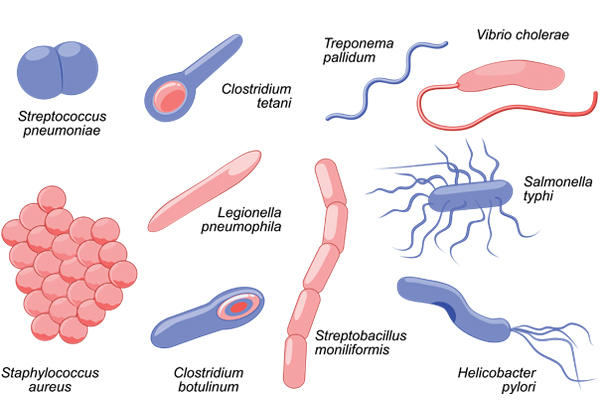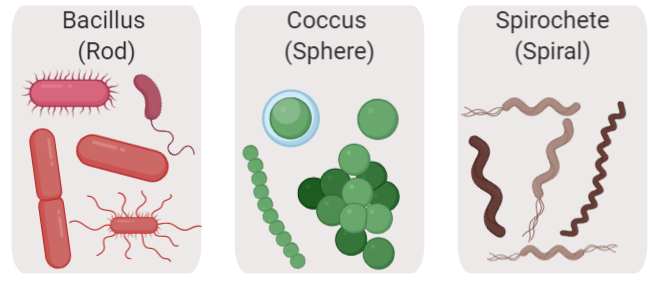

The ancestors of bacteria were unicellular microorganisms that were the first forms of life to appear on Earth, about 4 billion years ago. Phylogenetic tree of Bacteria, Archaea and Eucarya, with the last universal common ancestor at the root. These evolutionary domains are called Bacteria and Archaea. Although the term bacteria traditionally included all prokaryotes, the scientific classification changed after the discovery in the 1990s that prokaryotes consist of two very different groups of organisms that evolved from an ancient common ancestor. Unlike cells of animals and other eukaryotes, bacterial cells do not contain a nucleus and rarely harbour membrane-bound organelles. Once regarded as plants constituting the class Schizomycetes ("fission fungi"), bacteria are now classified as prokaryotes. Bacteria are important in sewage treatment and the breakdown of oil spills, the production of cheese and yogurt through fermentation, the recovery of gold, palladium, copper and other metals in the mining sector, as well as in biotechnology, and the manufacture of antibiotics and other chemicals. Antibiotics are used to treat bacterial infections and are also used in farming, making antibiotic resistance a growing problem. The most common fatal bacterial diseases are respiratory infections. However, several species of bacteria are pathogenic and cause infectious diseases, including cholera, syphilis, anthrax, leprosy, tuberculosis, tetanus and bubonic plague. Most of the bacteria in and on the body are harmless or rendered so by the protective effects of the immune system, and many are beneficial, particularly the ones in the gut. Most are in the gut, and there are many on the skin. Humans and most other animals carry vast numbers (approximately 10 13 to 10 14) of bacteria. The study of bacteria is known as bacteriology, a branch of microbiology. Most bacteria have not been characterised and there are many species that cannot be grown in the laboratory. Bacteria also live in symbiotic and parasitic relationships with plants and animals. In the biological communities surrounding hydrothermal vents and cold seeps, extremophile bacteria provide the nutrients needed to sustain life by converting dissolved compounds, such as hydrogen sulphide and methane, to energy. The nutrient cycle includes the decomposition of dead bodies bacteria are responsible for the putrefaction stage in this process.

Bacteria play a vital role in many stages of the nutrient cycle by recycling nutrients and the fixation of nitrogen from the atmosphere. Bacteria inhabit soil, water, acidic hot springs, radioactive waste, and the deep biosphere of Earth's crust. Typically a few micrometres in length, bacteria were among the first life forms to appear on Earth, and are present in most of its habitats. They constitute a large domain of prokaryotic microorganisms. "Schizomycetaceae" de Toni and Trevisan 1889īacteria ( / b æ k ˈ t ɪər i ə/ ( listen) singular: bacterium) are ubiquitous, mostly free-living organisms often consisting of one biological cell."Bacteria" ( Cohn 1872) Cavalier-Smith 1983.They actually perform very useful functions such as helping break down our food for digestion, protect against infection, and stimulate the immune system.Scanning electron micrograph of Escherichia coli rods Next we have Nonpathogenic Bacteria, which are completely harmless.

Spirilla- are spiral or corkscrew-shaped bacteria. They produce diseases such as tetanus, typhoid fever, tuberculosis, and diphtheria.ģ. They cause strep throat and blood poisoning.ĭiplo cocci- Spherical bacteria that grow in pairs. Strepto cocci- Pus-forming bacteria arranged in curved lines that resemble a string of beads.

These cause boils, pustules, and abscesses. Staphylo cocci- Pus-forming bacteria that grow in clusters like a bunch of grapes. Cocci- round-shaped that appear singly or in the following groups: Pathogenic bacteria have the following classifications:ġ. Bacteria have different shapes that help identify them. These are considered harmful because they may cause disease or infection. The two primary types of bacteria are:įirst, we will look at Pathogenic Bacteria.
BACTERIA SHAPES DEFINITION FREE
One-celled microorganisms with both animal and plant characteristics.īacteria can exist anywhere! They can be found on skin, air, water, decayed matter, clothing, under the free edge of the nails, and body secretions.


 0 kommentar(er)
0 kommentar(er)
